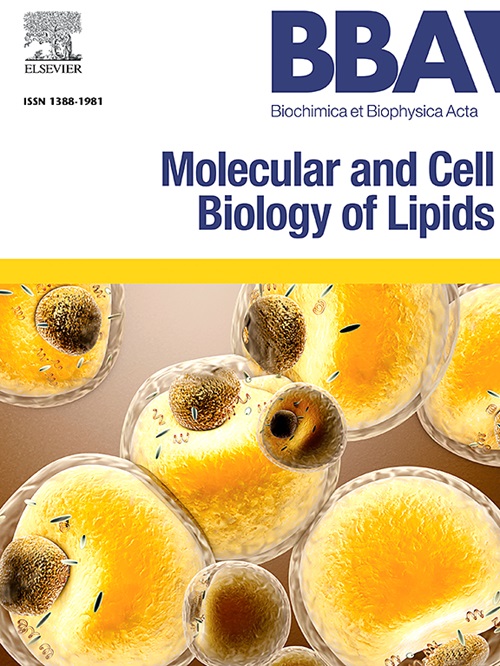肺表面活性蛋白SP-C调节肺泡II型细胞和巨噬细胞对脂质囊泡的摄取:脂质、棕榈酰化和环境的作用
IF 3.3
2区 生物学
Q2 BIOCHEMISTRY & MOLECULAR BIOLOGY
Biochimica et biophysica acta. Molecular and cell biology of lipids
Pub Date : 2025-09-08
DOI:10.1016/j.bbalip.2025.159688
引用次数: 0
摘要
肺表面活性蛋白C (SP-C)可能通过调节肺泡细胞的囊泡摄取在肺泡内稳态中起关键作用。本研究探讨了SP-C如何通过II型肺泡上皮细胞(AECII)和肺泡巨噬细胞(amφ)调节模型单层脂质囊泡的内化,重点研究了脂质组成、棕榈酰化状态以及与脂多糖(LPS)或其他疏水表面活性剂蛋白SP-B等外部刺激的相互作用。使用基于荧光的技术,我们证明了SP-C以脂质依赖的方式增强囊泡摄取。虽然AECII内化囊泡而不考虑脂质成分,但amφ显示出对具有特定脂质谱的囊泡的偏好。SP-C的棕榈酰化对于有效的囊泡摄取至关重要,强调了膜-蛋白相互作用在这一过程中的重要性。此外,SP-C与两种细胞类型中的酸性细胞器共定位,表明其参与细胞内运输和表面活性剂的稳态。值得注意的是,SP-C促进了amφ对LPS的摄取,可能有助于肺泡间隙的免疫调节。SP-C对代谢和肺免疫的贡献在涉及表面活性物质功能障碍或免疫失调的肺部疾病中具有重要意义。本文章由计算机程序翻译,如有差异,请以英文原文为准。
Pulmonary surfactant protein SP-C regulates lipid vesicle uptake by alveolar type II cells and macrophages: Role of lipids, palmitoylation, and environment
Pulmonary surfactant protein C (SP-C) may play a key role in alveolar homeostasis by modulating vesicle uptake in alveolar cells. This study explores how SP-C regulates internalization of model unilamellar lipid vesicles by type II alveolar epithelial cells (AECII) and alveolar macrophages (AMϕ), focusing on the effect of lipid composition, palmitoylation state, and interactions with external stimuli like lipopolysaccharides (LPS) or the other hydrophobic surfactant protein SP-B. Using fluorescence-based techniques, we demonstrated that SP-C enhances vesicle uptake in a lipid-dependent manner. While AECII internalize vesicles regardless of lipid composition, AMϕ show a preference for vesicles with specific lipid profiles. The palmitoylation of SP-C is essential for efficient vesicle uptake, highlighting the importance of membrane-protein interactions in this process. Furthermore, SP-C colocalizes with acidic organelles within both cell types, suggesting its involvement in intracellular trafficking and surfactant homeostasis. Notably, SP-C facilitates LPS uptake by AMϕ, potentially contributing to immune modulation in the alveolar spaces. The contribution of SP-C to metabolism and pulmonary immunity has important implications in lung diseases involving surfactant dysfunction or immune dysregulation.
求助全文
通过发布文献求助,成功后即可免费获取论文全文。
去求助
来源期刊
CiteScore
11.00
自引率
2.10%
发文量
109
审稿时长
53 days
期刊介绍:
BBA Molecular and Cell Biology of Lipids publishes papers on original research dealing with novel aspects of molecular genetics related to the lipidome, the biosynthesis of lipids, the role of lipids in cells and whole organisms, the regulation of lipid metabolism and function, and lipidomics in all organisms. Manuscripts should significantly advance the understanding of the molecular mechanisms underlying biological processes in which lipids are involved. Papers detailing novel methodology must report significant biochemical, molecular, or functional insight in the area of lipids.

 求助内容:
求助内容: 应助结果提醒方式:
应助结果提醒方式:


